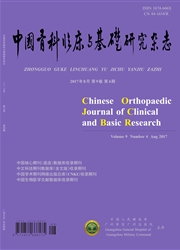

 中文摘要:
中文摘要:
目的测量股骨远端旋转力线相关参考轴的关系,为全膝关节置换术(TKA)股骨端假体旋转力线的定位提供理论依据。方法通过MIMICS软件观察75例健康成年人双侧股骨远端CT扫描轴位连续断层图片,应用三维坐标准确定位各解剖标志,选取股骨内上髁凹槽最明显处附近8张图片,分别找出股骨外科上髁轴与股骨后髁轴线(PCL)之间的夹角(股骨后髁角,PCA)、股骨解剖上髁轴与PCL之间的夹角(股骨髁扭转角,CTA)及前后轴线的垂线与PCL的夹角(APA);对股骨远端进行三维重建,使用各解剖标志坐标自动生成股骨远端旋转力线各参考轴的三维立体图像。在连续断层与三维重建图像上分别测量PCA、CTA和APA,同时比较三维图像上各角度不同性别、侧别之间的关系。结果连续断层图片上各角度测量结果:PCA为1.92(°—0.9°~4.2°)、APA为2.55(°0.2°~5.8°)、CTA为5.33(°2.1°~8.0°)。三维重建图片上男、女各角度测量结果:PCA为3.54°±0.61°、3.61°±0.39°,APA为3.39°±0.42°、3.66°±0.53°,CTA为6.21°±0.65°、6.02°±0.43°。三维重建图像上不同性别、侧别间PCA、CTA与APA的差异无统计学意义(P〉0.05)。结论连续二维断层图片上股骨远端旋转力线的参考参数变化范围大,不利于旋转力线的定位;基于CT重建技术在三维图像上可以准确测量旋转力线相关的参考参数,有利于TKA术中重建股骨远端精确的旋转力线。
 英文摘要:
英文摘要:
Objective To investigate the relationship of the reference axes related to rotational alignment of distal femur, and to provide theoretical basis for the positioning of femoral prosthesis rotational alignment duringtotal knee arthroplasty (TKA). Methods Seventy-five healthy adults were involved and the bilateral distal femurs were scanned by CT. Through MIMICS software, continuous section scanning images in axial view were observed, each anatomical landmark were positioned using 3D coordinate, 8 images around the image in which showed femoral epicondyle groove most obviously were selected, and the following angles were found: posterior condylar angle (PCA), which was formed by posterior condylar line (PCL) and surgical transepicondylar axis; condylar twist angle (CTA), which was formed by PCL and anatomical transepicondylar axis; the angle between the perpendicular line of anteroposterior axial line and PCL (APA). Then 3D reconstruction of distal femur based on continuous section images were perfbrmed, and 3D stereopictures for reference axes related to rotational alignment were generated automatically according to each anatomical landmark coordinate. PCA, APA, CTA in images of continuous section scanning as well as 3D reconstruction pictures were then measured, the differences of the angles between male and female, left side and right side were compared respectively in 3D reconstruction images. Results The angles in the continuous section scanning images were as follows: PCA was 1.92° (- 0.9°-4.2°), APA was 2.55°(0.2°-5.8°), and CTA was 5.33°(2.1°-8.0°). The angles in 3D reconstruction images were as follows: PCA was 3.54 °± 0.61 ° in male, and 3.61 ± 0.39 ° in female, APA was 3.39 °± 0.42 ° in male and 3.66 °± 0.53 ° in female, CTA was 6.21 °± 0.65 ° in male and 6.02 ± 0.43 ° in female, where showed no statistically differences between male and female (P 〉0.05). Also, the differences of each angle were no statistical significance between left
 同期刊论文项目
同期刊论文项目
 同项目期刊论文
同项目期刊论文
 Accuracy and efficacy of osteotomy in total knee arthroplasty with patient-specific navigational tem
Accuracy and efficacy of osteotomy in total knee arthroplasty with patient-specific navigational tem 期刊信息
期刊信息
